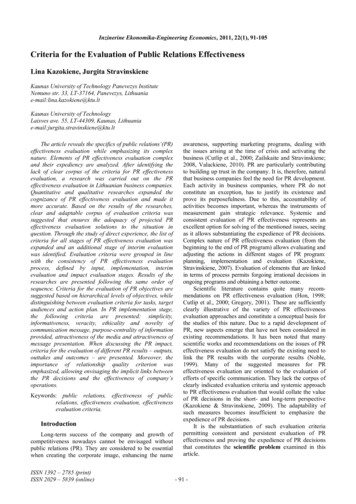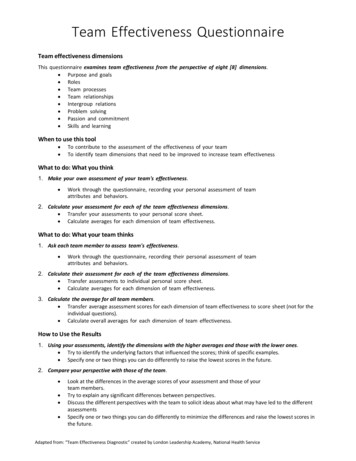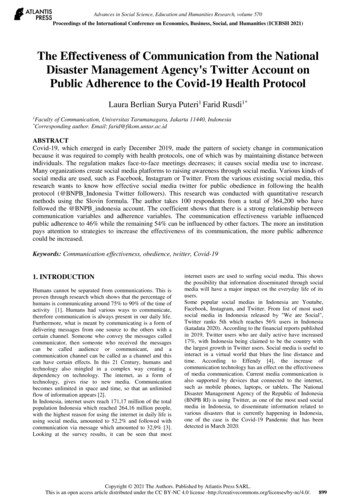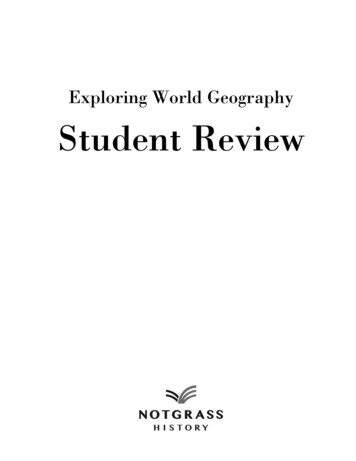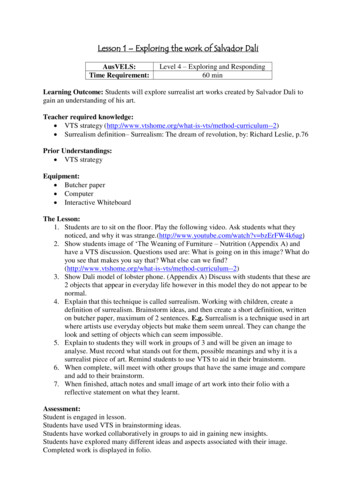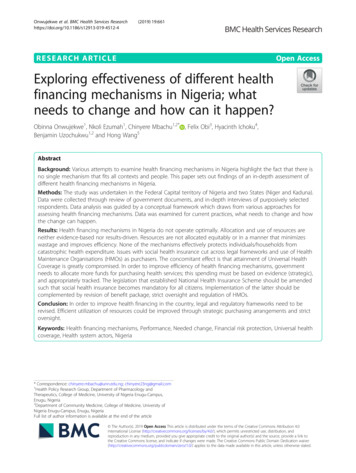
Transcription
Onwujekwe et al. BMC Health Services 2019) 19:661RESEARCH ARTICLEOpen AccessExploring effectiveness of different healthfinancing mechanisms in Nigeria; whatneeds to change and how can it happen?Obinna Onwujekwe1, Nkoli Ezumah1, Chinyere Mbachu1,2* , Felix Obi3, Hyacinth Ichoku4,Benjamin Uzochukwu1,2 and Hong Wang5AbstractBackground: Various attempts to examine health financing mechanisms in Nigeria highlight the fact that there isno single mechanism that fits all contexts and people. This paper sets out findings of an in-depth assessment ofdifferent health financing mechanisms in Nigeria.Methods: The study was undertaken in the Federal Capital territory of Nigeria and two States (Niger and Kaduna).Data were collected through review of government documents, and in-depth interviews of purposively selectedrespondents. Data analysis was guided by a conceptual framework which draws from various approaches forassessing health financing mechanisms. Data was examined for current practices, what needs to change and howthe change can happen.Results: Health financing mechanisms in Nigeria do not operate optimally. Allocation and use of resources areneither evidence-based nor results-driven. Resources are not allocated equitably or in a manner that minimizeswastage and improves efficiency. None of the mechanisms effectively protects individuals/households fromcatastrophic health expenditure. Issues with social health insurance cut across legal frameworks and use of HealthMaintenance Organisations (HMOs) as purchasers. The concomitant effect is that attainment of Universal HealthCoverage is greatly compromised. In order to improve efficiency of health financing mechanisms, governmentneeds to allocate more funds for purchasing health services; this spending must be based on evidence (strategic),and appropriately tracked. The legislation that established National Health Insurance Scheme should be amendedsuch that social health insurance becomes mandatory for all citizens. Implementation of the latter should becomplemented by revision of benefit package, strict oversight and regulation of HMOs.Conclusion: In order to improve health financing in the country, legal and regulatory frameworks need to berevised. Efficient utilization of resources could be improved through strategic purchasing arrangements and strictoversight.Keywords: Health financing mechanisms, Performance, Needed change, Financial risk protection, Universal healthcoverage, Health system actors, Nigeria* Correspondence: chinyere.mbachu@unn.edu.ng; chinyere23ng@gmail.com1Health Policy Research Group, Department of Pharmacology andTherapeutics, College of Medicine, University of Nigeria Enugu-Campus,Enugu, Nigeria2Department of Community Medicine, College of Medicine, University ofNigeria Enugu-Campus, Enugu, NigeriaFull list of author information is available at the end of the article The Author(s). 2019 Open Access This article is distributed under the terms of the Creative Commons Attribution 4.0International License (http://creativecommons.org/licenses/by/4.0/), which permits unrestricted use, distribution, andreproduction in any medium, provided you give appropriate credit to the original author(s) and the source, provide a link tothe Creative Commons license, and indicate if changes were made. The Creative Commons Public Domain Dedication o/1.0/) applies to the data made available in this article, unless otherwise stated.
Onwujekwe et al. BMC Health Services Research(2019) 19:661BackgroundIt is important to understand the current status of healthfinancing in Nigeria especially in comparison to national,regional and global goals and targets so as to provideevidence-based guidance for developing interventionsthat will be used to improve the financing of healthcareservices in the country. In addition, since health financing is one of the building blocks of health system, itslevel of functionality has direct effect on the overallfunctioning of the health system. A persistent and majorweakness of the country’s health system is the poorfunctioning of the health financing building block, whichis characterized by low public spending, very high levelsof out-pocket spending (one of the highest in the world),high incidence of catastrophic health spending and impoverishment due to spending on healthcare [1–4].A missing gap in knowledge in Nigeria is a holistic understanding of political, economic and other institutionalfactors that either undermine or support the implementation of different financing mechanisms in differentcontexts in Nigeria. This knowledge will be invaluable inappropriately shaping Nigeria’s policy and programmaticchoices that can improve health financing and acceleratethe achievement of Universal Health Coverage (UHC) inthe country. However, opportunities abound for Nigeriato increase coverage with social health insurance andother financial risk protection mechanisms and ultimately substantially improve the functioning of the healthsystem with healthy citizens [3].The political, economic and social contexts of healthfinancing mechanisms are important considerationsfor selecting which mechanisms have the potential tosucceed and survive [5, 6]. The manner in whichhealth financing mechanisms are organized couldaffect other social goals and hence individual choicesand options [7]. The two main sources of health financing in Nigeria, which are tax-based revenues and private contributions (from employers and individuals),lie closer to the country’s budgetary outcome on acausal chain that traces back to underlying social andpolitical determinants [8]. The balance of these twosources, and the levels of funding available, are ultimately determined by political structures, institutions,power groups, legal commitments, and fiscal space [8].Intentional review of these contextual factors will enable better understanding of conditions that enable orconstrain sustainability of particular health financingmechanisms [9].Efforts to increase public funding of health at all levels ofgovernment in Nigeria are being explored alongside otheroptions for health financing such as public-private partnerships and overseas development assistance [10, 11]. Healthfinancing mechanisms that aim at promoting equity areparticularly likely to challenge vested interests of differentPage 2 of 13actors [12, 13]. Actors’ views about what is desirable andfeasible within contexts, and what is politically acceptableneed to be taken into consideration in selecting appropriatehealth financing mechanisms [10, 11, 14–16]. It is necessaryto identify potential actors, understand their relative powerto influence change, their vested interests in the processand how this is related to the political and economic contexts in which they operate [12]. This will ensure that legitimate concerns and interests are considered, and alliancesof support, sufficient to overcome potential opposition tochange, are created [17–20].The Nigerian National Health Insurance Scheme (NHIS)was established in 1999, and officially launched in 2005, toprovide financial risk protection for citizens and reduce thehigh burden of out-of-pocket spending (OOPs) on individuals and households. In order to ensure that no one is leftout, the NHIS has a number of programs namely, socialhealth insurance for formal sector employees, communitybased health insurance, private health insurance, and voluntary health insurance [16]. The NHIS’ objective of ensuringaccess to quality health services for all Nigerians has alsobeen viewed as a positive step towards achieving universalhealth coverage (UHC) [9, 12, 21]. However, evidenceshows that NHIS has been unable to achieve intendedpopulation coverage with financial risk protection [22].Out-of-pocket expenditures constitute nearly 90% of thetotal private health spending, placing a significant burdenon households, and about 60% of all health spending is financed directly by households without insurance [10, 11].Ichoku and colleagues highlight that uneven distribution ofresources in Nigeria has had an effect on health care financing, particularly OOPs [23].Nigeria operates a three-tier federal system of government, and each tier is autonomous with executive andlegislative arms. However, over the years, local governments, which constitute the third tier of government,have considerably lost their autonomy as successive stategovernments are having more control over local government administration and funding [24]. The Nigeria constitution places health on the concurrent legislative list,such that both the federal, state and local governmentshave the responsibility to mobilize and deploy resourcesfor the provision of health services within their respective jurisdiction.Understanding the effectiveness of different health financing mechanisms in Nigeria and the modifications intheir functions that are needed to ensure improvementsin financial risk protection are important. It is also usefulto understand the bottlenecks that constrain the implementation of financing mechanisms such as social healthinsurance that can ensure financial risk protection tomost Nigerians. These will help to significantly increasethe level of financial risk protection in Nigeria in linewith the requirement for achieving UHC.
Onwujekwe et al. BMC Health Services Research(2019) 19:661This paper presents new information on the political, social and institutional contexts for health financing in Nigeria, which are essential evidence forimproving financial risk protection for most citizenstowards achievement of Universal Health Coverage inNigeria. The paper also examines the specific characteristics of major health financing mechanisms interms of mobilization, pooling of funds and purchasing functions. It also presents evidence on the performance of these health financing mechanisms aswell as the political, economic and institutional issuesconstraining or facilitating implementation. It highlights actors and their roles in different health financing mechanisms, changes that need to occur witheach mechanism and how these changes can happento ensure financial risk protection for all citizens, towards achievement of universal health coverage inNigeria.MethodsThis study used a qualitative approach to examine thecurrent situation of major health financing mechanisms inNigeria, and future prospects for achieving universalfinancial risk protection for all citizens. Review of relevantnational and state documents was complemented with indepth interviews (IDI) of key informants. The use ofmultiple data collection methods provided complementarity, triangulation and validation of data. Whereas review ofgovernment documents provided data that represent program intent, key informant interviews supplied data thatreflect actors’ interpretation and experience program implementation and performance. The study was undertaken inthe Federal Capital Territory and two other states -Nigerand Kaduna.Conceptual frameworkThe framework for conceptualization is drawn fromRibot’s programme paper on local actors, power andaccountability [21], Leichter’s and Collins et al.’smodels for categorizing contextual factors, WHOHealth Financing Diagnostics and Guidance [21–24],and The World Bank’s core protocol for assessing performance of countries’ health financing systems [25].Health care financing mechanisms and reforms evolvein many different contexts, and understanding the initial conditions in which they are being implementedor would be implemented is a useful starting point forassessing the reasons for pursuing them, the likely implications for the shape and pace of the mechanisms,and their potential sustainability in similar or differentcontexts. The nature of the system in which healthfinancing mechanisms occur also affects their transitioning; while the institutional legacies shape theenvironment in which they unfold.Page 3 of 13The Drivers of Change approach developed by DFIDstipulates that thinking more systematically about howchange occurs, the power relationships at stake and understanding institutional and structural factors affectinglack of political will leads to more realistic country assessments and planning, improved risk analysis, betterprioritization, more realistic timeframes and the development of better-informed strategies to influence andsupport health reform programmes [26]. Hence, a betterunderstanding of the context (including actors) in whichhealth financing mechanisms operate in Nigeria will enable identification and development of acceptable andsustainable health financing model(s) towards qualityand equitable health service delivery.Data collectionData were collected through review of government documents and in-depth interviews of key informants.Document review processDetailed review of existing government documents wasdone to identify the current health financing mechanisms in Nigeria and their contributions to the overallfunding for health, as well as all actors involved in healthfinancing in Nigeria. A document review template wasused to guide the review process.In-depth interviews with key informantsThe document review was followed by in-depth interviewsof key informants to explore the roles of key actors inhealth financing and the influence of contextual factors indetermining the performance of these mechanisms interms of health systems goals of equity, efficiency, qualityand sustainability. The in-depth interviews also exploredperceptions of key stakeholders on future prospects ofmajor health financing mechanisms for achieving universal financial risk protection in Nigeria.A topic guide was developed for this study and usedfor in-depth interviews (Additional file 1). The guide wasdeveloped in English language and pretested to ensureclarity of questions and constructs. All interviews wereconducted in English and audio-recorded with the consent of respondents to ensure that no relevant information was missed while taking hand-written notes.Respondents were purposively selected based on theirknowledge, experience, interest and active involvementin health financing in Nigeria. Key informants weredrawn from different categories of health system actorsto ensure maximum variability and representation ofdiverse perspectives. The respondents were public andprivate sector decision makers, particularly people ingovernment, the labour unions and professional associations. Respondents were recruited from health facilities, health maintenance organizations (HMOs) and
Onwujekwe et al. BMC Health Services Research(2019) 19:661Page 4 of 13community groups. The Federal Ministry of Health(FMOH), the NHIS, the NPHCDA, the FCT health departments and State Ministries of Health were themajor loci for data collection. Federal and StateMinistries of Finance and Budget & Planning, and legislators from State and National Assembly were alsoincluded. A total of 32 respondents were interviewed.Partners, and Academia. Actors external to the health sector include the Federal and State Governments, NationalAssembly, Ministry of Finance, Ministry of Budget andNational Planning, Federal Inland Revenue Service, Customs, the Budget Office, Central Bank, Accountant GeneralOffice, Auditor General Office, among others. The keyactors and their roles are summarized in Table 2.Data analysisPerformance of major health financing mechanisms inNigeriaQualitative data were transcribed and coded (manuallyand using NVivo). Audio-recorded interviews were transcribed verbatim and accuracy checks done to ensuretheir validity. A careful study of all the transcripts wasundertaken in order to obtain a general view and makesense of the data. Transcripts that were particularly richin information were studied in detail and responsescoded. The codes were categorised and linked intoclusters of relatively similar responses (themes and subthemes) that represent key issues of institutional assessment of different financing mechanisms. These themeswere used for coding and analysis of subsequent transcripts. The analysis of each major financing mechanismwas undertaken in terms of health financing functions ofresource generation/revenue mobilization; pooling andmanagement of resources; and purchasing of services.Furthermore, the performance of each major healthfinancing mechanism was analyzed in terms of equity,efficiency, sustainability, quality of services and ability toprevent consumers from incurring catastrophic healthexpenditures.ResultsMajor health financing mechanisms in NigeriaThe major health financing mechanisms in Nigeria arenamely: (i) government budget using general taxrevenue; (ii) direct out-of-pocket payments; (iii) a socialinsurance scheme known as the Formal Sector SocialHealth Insurance Programme (FSSHIP) that is implemented by the National health insurance scheme; and(iv) donor funding. Other health financing mechanismsinclude: demand-side financing through conditional cashtransfers (CCT), and community-based health insurance(CBHI). A summary of the characteristics of the healthfinancing mechanisms with respect to health financingfunctions of resource generation, pooling and management of funds, and purchasing of health services ispresented in Table 1.Actors involved in health financing at the federal levelThere are several actors within and external to the healthsector that were identified as key role players in financingof the health sector in Nigeria. Actors within the health sector include the Federal Ministry of Health and its Agenciesat all levels, Private Sector, Civil Society, DevelopmentA set of five key performance indicators were used toexamine participants’ perspective of the major healthfinancing mechanisms in Nigeria, and the findings arepresented in detail below. The performance indicatorsthat were used are efficiency, equity, quality of care,effect on catastrophic health expenditure, and sustainability. Table 3 shows a summary of perceived performance of each health financing mechanism.Government budgetEfficiency The use of government budget for healthcarefinancing was perceived to be largely inefficient becausedisproportionately large proportion of the health budgetis allocated to personnel cost without commensurateproductivity, and the amount of money that is effectivelyavailable for service delivery is inadequate. Hence, valuefor money is difficult to ascertain and almost impossibleto achieve under the current arrangement.“The health sector has one of the highest budgets forpaying staff salaries compared to other ministries. Weput so much into the health sector and we keep gettingincessant strikes by doctors and other health workers”(Government official).Additionally, budget allocations to the health sector arenot based on evidence of demographic considerations orepidemiological factors such as disease burden. As aresult of this, government funding for health is grosslyinadequate. According to a government official;“Sometimes it (government budget for health) is 4% ofthe total budget, sometimes, it is 6%. I think the bestwe ever had is about 7%”.Equity National health budget was considered inequitable for a couple of reasons. Firstly, it mainly fundstertiary hospitals, whereas the highest disease burdensare attended to at the primary and secondary carelevels. And although National Primary Health CareDevelopment Agency (NPHCDA) gets a fraction ofthe annual health budget, the percentage of total
Onwujekwe et al. BMC Health Services Research(2019) 19:661Page 5 of 13Table 1 Characteristics of major health financing mechanisms in NigeriaResource generationPooling and management of fundsPurchasing of health servicesGovernmentbudgetShare of statutory allocation from FAACInternally generated revenue fromincome tax, value-added tax, tariffs, saleof government bonds, etc.Special intervention fundsFunds are pooled into the federationaccount from where budgetaryallocations are made.Disbursements are made quarterly fromMinistry of Finance to Ministry of Healththrough the Central BankHealth services are purchased throughthe Ministry of Health and relatedagencies for line items and global budget.Out of pocketpaymentIndividual and households generate fundsfor health through: (i) income from paidemployment and business, (ii) borrowingfrom family and friends, (iii) charity andphilanthropyPooled within the household andmanaged by the head of the householdor a representative.There is no central pool for revenuegenerated for OOP.Individuals and households make directcash payments at the point of accessinghealth care.Some health services like investigationsand drugs could be provided through athird party such as diagnostic laboratory,pharmacy shop or patent medicinevendor.FSSHIPFormallylaunched in 2005Covers onlyFederalgovernmentemployees andbeneficiariesDesigned to be contributory – 10% fromemployers and 5% from employee ofbasic salary. However, only the employeris currently contributing (i.e. 10%).Pooling is done centrally by NHIS into adedicated Bank accountHealth Maintenance Organizations(HMOs) are contracted to purchase healthservices (within an approved package ofcare) from accredited providersCommunitybased healthinsuranceFunds are generated throughcontribution of premiums by registeredenrolees.Each scheme has its own poolingmechanism.Depends on the design, but purchasingcan be done directly from serviceproviders or through third parties such asHMOs.Donor fundingUN agencies through UNDP’s NEXBilateral agencies - Country tax revenueDevelopment Banks – contributions ofmember countriesOther sources – philanthropists, donorcooperation, etc.Each donor agency pools its fundseparately and channels it through grantsand concessional loans using aidmodalities such as technical assistance,project financing, and little or no directbudget support.Development aid that is sent throughregions to respective countries aremanaged by designated parastatals,specifically Ministry of Budget andNational Planning in Nigeria.Services are purchased through differentmodels depending on financial riskassessment of recipient parastatal/organization.Direct implementation (by donors) orreimbursement models are used iffinancial risk is high, while direct transfersare used when financial risk is lowhealth expenditure allocated to primary health care(PHC) was perceived to be incommensurate withdisease burden.“Even though the small allocation to health sector,we think about 90% of Nigerians suffer from PHCchallenges compared to tertiary challenges”.Secondly, it was stated that there is no system to ensure financial resources are fairly distributed acrossgeographic regions in the country considering theirdifferential poverty and vulnerability levels. This wasclearly stated by a respondent;“There is inequity in the distribution ofgovernment’s resources and poverty level varies indifferent parts of the country. Some states aregenerating more money than others, and budgetmore for health. Some states are disadvantaged bygeography and insecurity like those in the NE.We’re yet to finance healthcare in a way thatensures equity” (Government official).Quality of service Although health services were perceived to be better in tertiary hospitals compared to primary and secondary hospitals, respondents inferred thatquality of care varied from facility to facility dependingon the dimension of quality assessed. Generally, theywere of the opinion that quality of health care financedfrom government budget was sub-optimal in all publichospitals in terms of infrastructure, availability of drugsand skilled health workforce, waiting times and attitudeof health workers towards clients.Prevention of households from incurring catastrophicOOPs The funding for health that is derived fromgovernment budget was perceived, in principle, to haveno impact on OOP. This is because majority of theservices provided in tertiary hospitals, for instance, are
Onwujekwe et al. BMC Health Services Research(2019) 19:661Page 6 of 13Table 2 Roles of key actors in health financing in NigeriaActor categoryKey playersRolesFederal government andline MinistriesFederal Executive Council (FEC)Approves policies that have macroeconomic and financial implications beforeoperationalizationMinistry of FinanceCritical role in advising FEC to ensure that health financing reforms align well withmacroeconomic realities of the CountryNational Assembly (NASS)Responsible for appropriation of budget to health sector and monitoring itsimplementation through standing (Senate or House) Committees on HealthFederal Ministry of Health Federal Ministry of Health (FMOH)and its AgenciesPivotal in health financing. Statutorily responsible for developing health policies anddesigning health programs and interventions.The health financing unit of FMOH is strategically positioned to promote the use ofevidence in design and implementation of health financing reforms. It coordinatesthe Technical Working Group on health financing and engages other stakeholdersto ensure support of health financing reforms. FMOH has been working with NHISand NPHCDA in development of guidelines for management of Basic HealthcareProvision Fund (BHCPF).National Health Insurance Scheme(NHIS)Runs and manages the Formal Sector Social Health Insurance Program (FSSHIP) andstatutorily oversees the operations of HMOS in Nigeria. NHIS Zonal and State officesare positioned to provide needed support for State health insurance schemes.National Primary Health CareDevelopment Agency (NPHCDA)Focuses on improving quality and uptake of essential health services for vulnerablegroups through interventions that incorporate both supply and demand-side financing such as the Midwives Service Scheme (MSS), Subsidy Reinvestment Program(SURE-P), and the Nigeria State Health Investment Project (NSHIP).To underscore the role of NPHCDA, a respondent said that ‘NPHCDA’s role is toensure that services are provided at the PHC level. They have run performance-based financing pilots in some States, and the lessons learnt and experiences gained would beuseful going forward”Development partnersand other donor agenciesPrivate sectorInvolved in pooling and management of financial resourcesTechnical expertise and support in health financing and public financemanagement. Technical support with strategic purchasing of services based on theirexperiences in using implementing partners (IPs) to deliver critical healthinterventions to Nigerians. Through this, they have been able to strengthen servicedelivery, contracting, logistics and payment mechanisms. “For example, CHAI hashelped to drive down the cost of drugs by creating a market for drugs. Reference pricingaround products and drugs can help us do strategic purchasing of vaccines andessential drugs. DPs have gained experience with contracts with vendors andcommunities, and making use of their IPs, we can strike a lasting relationship inpurchasing services which can help improve quality of health infrastructure and services”Upstream actors (e.g. PrivateSector Health Alliance)The upstream actors are those involved in resource mobilization and domesticrevenue mobilization, as well as investors.The upstream players also include foundations, and corporate organizations whoearmark resources for corporate social responsibility activities.Downstream actorsThe downstream players are mainly the service providers and it was acknowledgedby some respondents that “over 60–65% of health services are delivered by the privatesector in Nigeria”.Health MaintenanceOrganizationsInterface between government and private providers of healthcare in the socialhealth insurance schemesAcademiaExpand knowledge base and generate evidence to bridge the policy-research gap.Build capacity for health financingServe as a repository of knowledgeCitizens and citizengroupsStates and LocalgovernmentsCivil Society Organizations (CSOs)Ensure quality of care by guaranteeing accountability and value for moneyInforming and mobilizing citizensMediaInforming and mobilizing citizensImportant roles in initiating and sustaining health financing reforms.Who did you make policy for when all federal constituencies are situated within a stateand their LGAs?”States are expected to own and domesticate all health policies that are approvedand adopted by the National Council on Health, to ensure proper implementation.CBHI and mutual aid are often managed at the LGA level by LGA health authority.
Onwujekwe et al. BMC Health Services Research(2019) 19:661Page 7 of 13Table 3 Participants’ perceptions of performance of major health financing mechanisms in NigeriaGovernment budgetOOPFSSHIPCBHIDonor fundingEfficiencyHighly inefficient.Funds are inadequate anddisproportionately allocatedb/w personnel and servicedelivery.Allocation is not based onepidemiologic ordemographic evidence.Hence, no value for money.Regressive andhighly inefficient.Pool isfragmented.Running cost ishigh.NHIS has made efficiencygains but FSSHIP is inefficientbecause employees have notstarted contributing.Use of HMOs s admin costand s what is available forservice delivery. Difficult toascertain value for money.Efficiency is lowbecause size ofpool is toosmallOpinions varied.Efficient because it employs costsaving mechanisms to achieve highimpact, and fiduciary and accountability requirements are strict.Inefficient because resources aresometimes wasted due to weakcoordination of donor funds.EquityInequitable.Mainly funds tertiaryhospitals at the expense ofneeded primary care.No fairness in geographicdistribution of resources.Inequitable.Access tohealthcare isdetermined byability to pay.Limited to FG employees and Inequitable.beneficiaries. Majority ofCoverage isNigerians are not coveredlowQuality ofcareGenerally suboptimal butvaries across facilities –quality of care is better intertiary hospitalsDirectly linked to Benefit package is notaffordability and comprehensive an
Therapeutics, College of Medicine, University of Nigeria Enugu-Campus, Enugu, Nigeria 2Department of Community Medicine, College of Medicine, University of Nigeria Enugu-Campus, Enugu, Nigeria Full list of author information is available at the end of the article Onwujekwe et al. BMC Health Services Research (2019) 19:661

